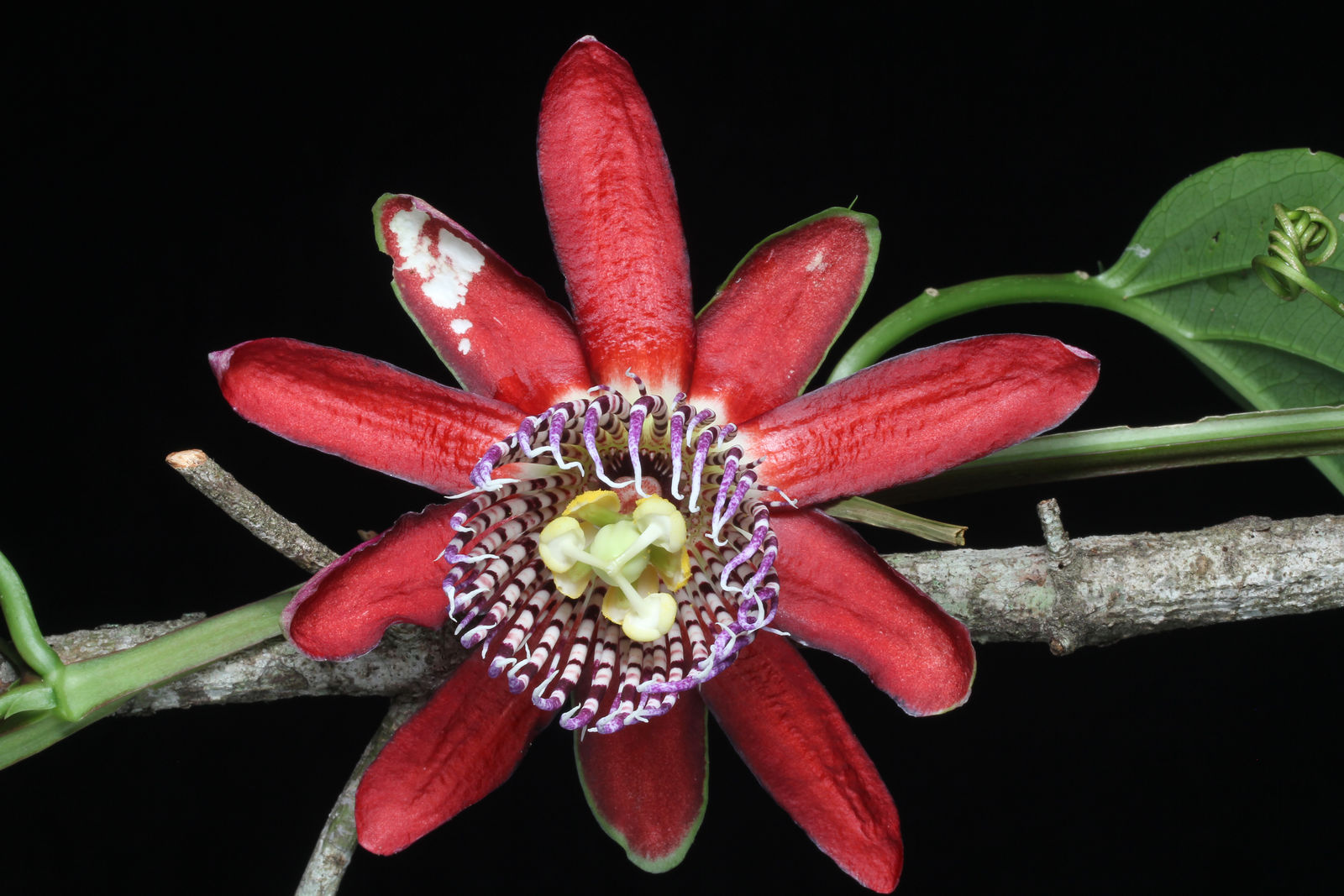Family: Passifloraceae
Author: Curtis
Bibliography: Bot. Mag. 2: t. 66 (1788)
Year: 1788
Status: accepted
Rank: species
Genus: Passiflora
Vegetable: False
Observations: Ecuador to Brazil and NE. Argentina
Description
The Wingstem passionflower, known scientifically as Passiflora alata, is a captivating member of the Passifloraceae family. This perennial climbing vine is highly esteemed for both its striking beauty and unique botanical characteristics. It thrives in various parts of South America, with a natural range extending from Ecuador to Brazil and northeastern Argentina.
Passiflora alata captures the eye with its lavish, intricate flowers and lush, evergreen foliage. The flowers, which are typically large and aromatic, feature a mesmerizing combination of colors that attract a multitude of pollinators, including bees and butterflies. The blossoms exhibit a rich palette of reds and purples, often highlighted with contrasting hues around the petals and corona, making them a stunning addition to any garden or natural setting.
One of the notable features of the Wingstem passionflower is its winged stems, from which it derives its common name. These wing-like extensions along the stem provide added support and stability as the vine climbs and sprawls across surfaces. The plant’s adaptability to various substrates and its vigorous growth habit make it an excellent choice for covering trellises, arbors, or fences, providing both aesthetic appeal and functional greenery.
In addition to its ornamental value, Passiflora alata bears fruit that is not only edible but also delectable. The fruits, often referred to as “fragrant granadillas,” are oval, smooth, and yellow when ripe, containing a sweet, aromatic pulp that is enjoyed fresh or used in beverages and desserts. This edible aspect adds an extra layer of utility and charm to cultivating the Wingstem passionflower.
Historically, the botanical allure of Passiflora alata was acknowledged as early as 1788, when Curtis featured it in the Bot. Mag. 2: t. 66. Since then, its popularity has only grown, making it a beloved species among horticulturists and plant enthusiasts alike.
With its enchanting flowers, distinctive winged stems, and delicious fruits, the Wingstem passionflower continues to captivate those who encounter it, earning its place as a treasured specimen in gardens and wild landscapes across its native range.
Common Names
Eng: wing-stemmed passion flower, wingstem passionflower
Por: maracujá-açú, maracujá-doce, maracujá-grande, maracutão
Spa: pasionaria
En: Wingstem passionflower, Winged Passion Flower, Passionflower, Winged-stem passion flower, Wing-stemmed passion flower
Zh: 香蜜百香果
He: שעונית חיקית
Ml: പാസിഫ്ലോറ അലറ്റ
Fa: گل ساعتی ساقه بالدار
Pt: Maracujá-grande, Maracutão, Maracujá-açú, Maracujá-doce
Es: Pasionaria
Sv: Doftpassionsblomma
Synonyms
- Passiflora alata var. latifolia ((DC.) Mast.)
- Passiflora alata var. brasiliana ((Desf.) Mast.)
- Passiflora mauritiana (Thouars)
- Passiflora latifolia (DC.)
- Passiflora angulata (Sweet ex Mast.)
- Passiflora sarcosepala (Barb.Rodr.)
- Passiflora alata var. acuminata (Graham)
- Passiflora tetradena (DC.)
- Passiflora brasiliana (Desf.)
- Passiflora maliformis (Vell.)
- Passiflora alata var. pedunculata (Graham)
- Passiflora alata var. mauritiana ((Thouars) Mast.)
- Passiflora oviformis (M.Roem.)
- Passiflora alata var. insignis (Graham)
- Passiflora pyriformis (DC.)
- Passiflora mascarensis (C.Presl)
- Passiflora bicolorata (W.H.Baxter)
- Passiflora pedunculata (Mast.)
- Passiflora citrifolia (Salisb.)
Distribution
- Argentina Northeast (native)
- Brazil North (native)
- Brazil Northeast (native)
- Brazil South (native)
- Brazil Southeast (native)
- Brazil West-Central (native)
- Ecuador (native)
- Paraguay (native)
- Peru (native)
- Costa Rica (introduced)
- French Guiana (introduced)
- Mauritius (introduced)
- Mexico Southeast (introduced)
- Mexico Southwest (introduced)
- Réunion (introduced)
Additional Images

© copyright of the Board of Trustees of the Royal Botanic Gardens, Kew.

© copyright of the Board of Trustees of the Royal Botanic Gardens, Kew.

© copyright of the Board of Trustees of the Royal Botanic Gardens, Kew.
Flower
Taken Apr 5, 2021 by Salado Carrera Gustavo Enrique (cc-by-sa)
Taken Oct 18, 2022 by Felix Fernandez (cc-by-sa)
Taken Sep 15, 2021 by mac lean mac lean (cc-by-sa)
Taken Oct 24, 2020 by Maku Jeanne (cc-by-sa)
Taken Apr 8, 2018 by Gaelle Legagneur (cc-by-sa)
Habit
Taken Apr 14, 2021 by Trap Hers (cc-by-sa)
Taken Jul 26, 2021 by Trap Hers (cc-by-sa)
Fruit
Taken May 17, 2020 by JP Corrêa Carvalho (cc-by-sa)
Taken Jul 26, 2021 by Trap Hers (cc-by-sa)
Taken Oct 30, 2021 by augusto sergio (cc-by-sa)
Taken Oct 9, 2019 by Dias João (cc-by-sa)
Taken Jan 12, 2022 by Igor Marins (cc-by-sa)
Leaf
Taken Mar 25, 2020 by Paola Rieger (cc-by-sa)
Taken Oct 12, 2021 by mac lean mac lean (cc-by-sa)
Taken May 17, 2020 by JP Corrêa Carvalho (cc-by-sa)
Taken Jul 26, 2021 by Trap Hers (cc-by-sa)
Taken May 3, 2021 by Giovanna Paiva (cc-by-sa)
Other
Taken Jul 18, 2022 by Anatas (cc-by-sa)
Sources
- WFO (No URL)
- IPNI (No URL)
- GBIF (https://www.gbif.org/species/2874181)
- POWO (http://powo.science.kew.org/taxon/urn:lsid:ipni.org:names:321312-2)
- PlantNet (https://identify.plantnet.org/species/the-plant-list/Passiflora alata Curtis)


















